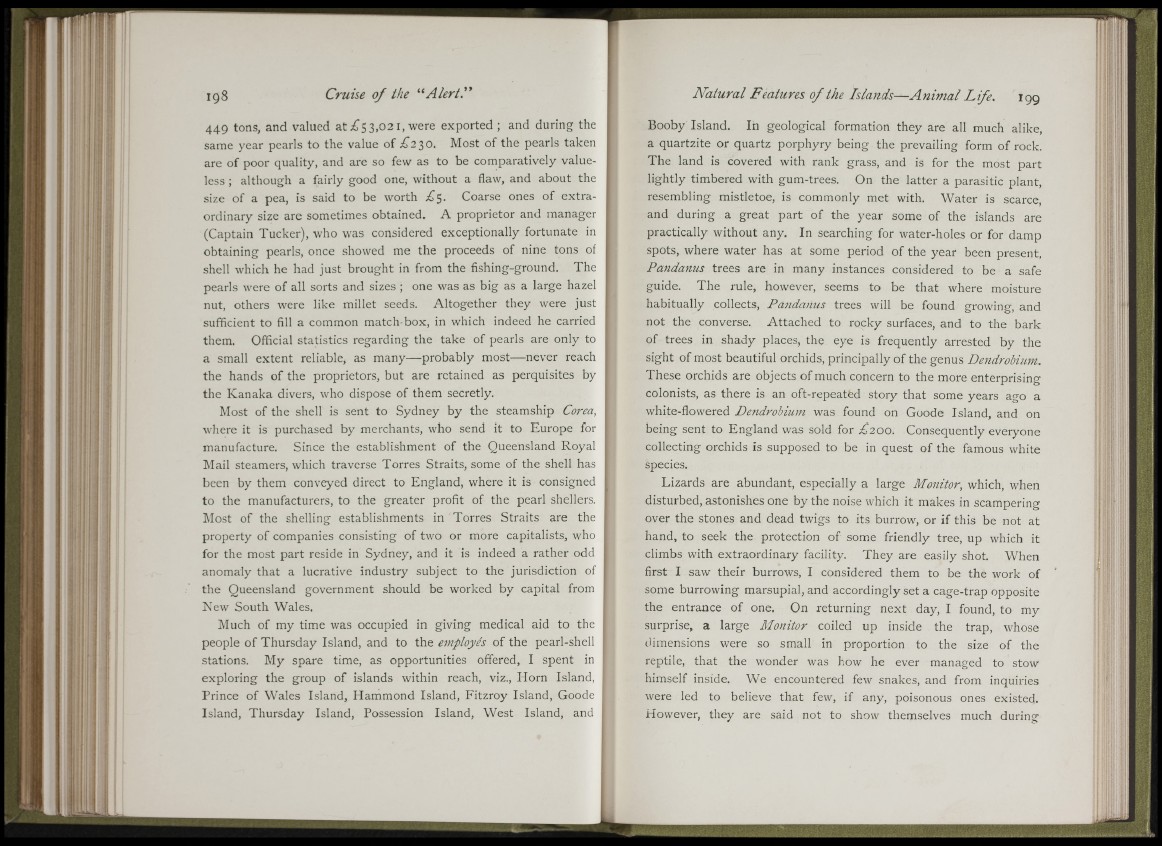
449 tons, and valued at 3,02 i, were exported ; and during the
same year pearls to the value of ;6'2 30. Most of the pearls taken
are of poor quality, and are so few as to be comparatively valueless
; although a fairly good one, without a flaw, and about the
size of a pea, is said to be worth £><,. Coarse ones of extraordinary
size are sometimes obtained. A proprietor and manager
(Captain Tucker), who was considered exceptionally fortunate in
obtaining pearls, once showed me the proceeds of nine tons of
shell which he had just brought in from the fishing-ground. The
pearls were of all sorts and sizes ; one was as big as a large hazel
nut, others were like millet seeds. Altogether they were just
sufficient to fill a common match box, in which indeed he carried
them. Official statistics regarding the take of pearls are only to
a small extent reliable, as many— probably most— never reach
the hands of the proprietors, but are retained as perquisites by
the Kanaka divers, who dispose of them secretly.
Most of the shell is sent to Sydney by the steamship Corea,
where it is purchased by merchants, who send it to Europe for
manufacture. Since the establishment of the Queensland Royal
Mail steamers, which traverse Torres Straits, some of the shell has
been by them conveyed direct to England, where it is consigned
to the manufacturers, to the greater profit of the pearl shellers.
Most of the shelling establishments in Torres Straits are the
property of companies consisting of two or more capitalists, who
for the most part reside in Sydney, and it is indeed a rather odd
anomaly that a lucrative industry subject to the jurisdiction of
the Queensland government should be worked by capital from
New South Wales.
Much of my time was occupied in giving medical aid to the
people of Thursday Island, and to the employés of the pearl-shell
stations. My spare time, as opportunities offered, I spent in
exploring the group of islands within reach, viz., Horn Island,
Prince of Wales Island, Hammond Island, Fitzroy Island, Goode
Island, Thursday Island, Possession Island, West Island, and
Booby Island. In geological formation they are all much alike,
a quartzite or quartz porphyry being the prevailing form of rock.
The land is covered with rank grass, and is for the most part
lightly timbered with gum-trees. On the latter a parasitic plant,
resembling mistletoe, is commonly met with. Water is scarce,
and during a great part of the year some of the islands are
practically without any. In searching for water-holes or for damp
spots, where water has at some period of the year been present,
Pandanus trees are in many instances considered to be a safe
guide. The rule, however, seems to be that where moisture
habitually collects, Pandanus trees will be found growing, and
not the converse. Attached to rocky surfaces, and to the bark
of trees in shady places, the eye is frequently arrested by the
sight of most beautiful orchids, principally of the genus Dendrobium.
These orchids are objects of much concern to the more enterprising
colonists, as there is an oft-repeated story that some years ago a
white-flowered Dendrobium was found on Goode Island, and on
being sent to England was sold for £200. Consequently everyone
collecting orchids is supposed to be in quest of the famous white
species.
Fizards are abundant, especially a large Monitor, which, when
disturbed, astonishes one by the noise which it makes in scampering
over the stones and dead twigs to its burrow, or if this be not at
hand, to seek the protection of som.e friendly tree, up which it
climbs with extraordinary facility. They are easily shot. When
first I saw their burrows, I considered them to be the work of
some burrowing marsupial, and accordingly set a cage-trap opposite
the entrance of one. On returning next day, I found, to my
surprise, a large Monitor coiled up inside the trap, whose
dimensions were so small in proportion to the size of the
reptile, that the wonder was how he ever managed to stow
himself inside. We encountered few snakes, and from inquiries
were led to believe that few, if any, poisonous ones existed.
However, they are said not to show themselves much during